'Cry, the Beloved Country' is set in 1946 in South Africa, where huge social and political changes had taken place at that time. It was first published in 1948 when Nationalist Party came to power and soon after that apartheid was introduced, establishing the separation of races in every aspect of daily life. Black people were refused voting rights and their role in the Parliament weakened. Alan Paton, in his novel had depicted the differences and similarities between living conditions of the blacks and whites during that time, underlining the racial inequality and injustice in South Africa.
The characters in the novel can be divided into groups, regarding either of their surroundings, beliefs or the racial background. Firstly, there is the rural society of black people. They live in villages and small communities where everyone knows each other, where people are mostly farmers working hard from day to day to save money for their children's future.
Rural lifestyle is best exemplified by Stephen Kumalo - the pastor of Ixopo in Ndotsheni. Kumalo and other villagers represent family, tradition, religion, morality and stability. Right at the beginning of the book Paton describes the land surrounding Ixopo, the
hills and mountains, where "the grass is rich and matted, you cannot see the soil. But the rich green hills break down" and the valley below is eroded and bare, the soil overexploited by humans, "too many cattle feed upon the grass, and too many fires have burned it." Everything dried up during long periods of drought. People do not know how to fight erosion, none of them know how to build a dam, there is nobody to teach them farming methods, even if there was somebody with proper education, he would leave for the towns to find better occupation then farming...


